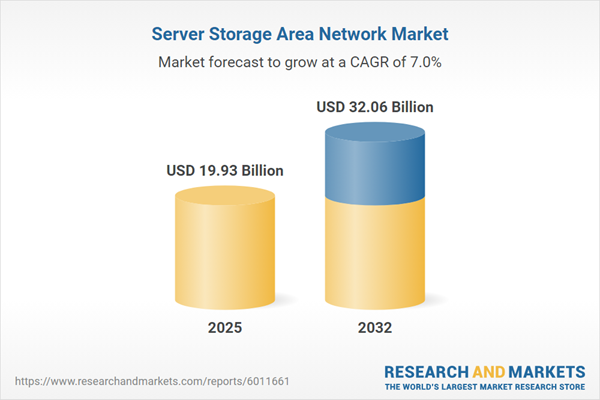Speak directly to the analyst to clarify any post sales queries you may have.
Enterprises are accelerating digital initiatives, making a robust server storage area network (SAN) indispensable for cohesive data management and operational agility. As organizations evaluate infrastructure strategies, SAN solutions now enable centralized control, reduce management complexity, and enhance adaptability across rapidly evolving IT environments.
Market Snapshot: Server Storage Area Network Market Size and Growth
The global server storage area network market recorded a valuation of $18.65 billion in 2024 and is projected to reach $19.93 billion in 2025, with forecasts indicating an expansion to $32.06 billion by 2032. This growth reflects a 7.01% compound annual growth rate (CAGR). Organizations are turning to advanced SAN technologies to consolidate data, improve throughput, and ensure consistent network frameworks. Enhanced adoption of software-defined SANs, robust virtualization, and streamlined integration with hybrid IT models are key trends supporting sector momentum. The primary keyword "server storage area network" is central to this market's relevance for contemporary enterprises.
Scope & Segmentation of the Server Storage Area Network Market
This analysis outlines the critical factors and segments influencing purchasing decisions and strategic IT planning in the enterprise SAN domain. Senior decision-makers can use this insight to refine operational investments and align with emerging infrastructure needs.
- Storage Technology: FCoE (Fibre Channel over Ethernet) offers flexible, scalable connectivity for hybrid environments. Fibre Channel delivers reliable data transmission for core business functions, while iSCSI supports efficient virtualization and cost-effective expansion in distributed architectures.
- Deployment Mode: Cloud-based SANs accommodate diverse business models and enable rapid adaptation to changing workloads, with options spanning public, private, and hybrid approaches. On-premise deployments offer direct control, fitting organizations requiring local oversight or regulatory compliance.
- End-User Industry: Finance, government, healthcare, IT, telecom, media, and manufacturing all employ SAN platforms to enhance regulatory compliance, support data-intensive workloads, and ensure systems reliability in complex information landscapes.
- Organization Size: Large enterprises tap advanced SAN capabilities to manage analytics and distributed operations, while SMBs use streamlined solutions to achieve targeted growth and resource efficiency.
- Regional Coverage: Market growth varies by region, influenced by infrastructure maturity, digital adoption trends, and local regulatory environments across the Americas, Europe, Middle East, Africa, and Asia-Pacific. Understanding these regional drivers ensures optimal integration and deployment choices.
- Key Vendors: Major market participants include Dell Technologies, Hewlett Packard Enterprise, NetApp, Huawei Technologies, IBM, Hitachi Vantara, Inspur Information, Pure Storage, Fujitsu, and NEC, all advancing SAN functionality through continuous innovation and collaboration.
Key Takeaways for Senior Decision-Makers
- Centralized SAN architectures support swift adaptation to shifting business requirements, enabling more agile data management strategies.
- Modern SAN deployments foster seamless integration with multi-cloud and hybrid IT frameworks, making workload modernization and migration practical for complex organizations.
- Evolving SAN technologies such as NVMe and flash storage drive faster data access, minimizing latency and empowering responsive application performance.
- Enterprises in sectors subject to regulation rely on SAN infrastructure to maintain data integrity, consistent performance, and meet compliance standards.
- Leaders seek SAN solutions with straightforward management, scalability, and ready compatibility with emerging platforms to minimize operational friction.
- Procurement strategies increasingly value modular SAN configurations and ongoing collaboration with vendors to ensure long-term flexibility and readiness for technology evolution.
Tariff Impact on SAN Supply Chain and Pricing
Recent U.S. tariffs on crucial SAN components, such as semiconductor controllers and optical transceivers, are influencing vendor supply chains. Many vendors are shifting to diversified sourcing and prioritizing local manufacturing where possible. This approach helps stabilize supply reliability and manage procurement expenses amid fluctuating trade policies, providing both suppliers and enterprises with improved control over operational costs.
Methodology & Data Sources
This report draws on direct interviews with IT leaders and procurement specialists, analysis of global SAN deployment data, and reviews of financial and vendor engagement documentation. These sources provide actionable, data-driven insights for market evaluation.
Why This Server Storage Area Network Report Matters
- Enables IT and procurement teams to benchmark and strengthen SAN investment strategies for long-term infrastructure alignment.
- Delivers guidance on refining procurement, supporting compliance, and anticipating risks in response to quickly evolving technology scenarios.
- Clarifies the landscape of vendor differentiation and regulatory influences, giving senior leaders the confidence to make informed technology decisions.
Conclusion
Strategic investments in SAN architecture equip organizations to nurture resilience and streamline digital transformation. Aligning SAN solutions with overall business strategy positions enterprises to quickly adapt as priorities and market opportunities evolve.
Additional Product Information:
- Purchase of this report includes 1 year online access with quarterly updates.
- This report can be updated on request. Please contact our Customer Experience team using the Ask a Question widget on our website.
Table of Contents
3. Executive Summary
4. Market Overview
7. Cumulative Impact of Artificial Intelligence 2025
Companies Mentioned
The companies profiled in this Server Storage Area Network market report include:- Dell Technologies Inc.
- Hewlett Packard Enterprise Company
- NetApp, Inc.
- Huawei Technologies Co., Ltd.
- International Business Machines Corporation
- Hitachi Vantara LLC
- Inspur Information Co., Ltd.
- Pure Storage, Inc.
- Fujitsu Limited
- NEC Corporation
Table Information
| Report Attribute | Details |
|---|---|
| No. of Pages | 183 |
| Published | November 2025 |
| Forecast Period | 2025 - 2032 |
| Estimated Market Value ( USD | $ 19.93 Billion |
| Forecasted Market Value ( USD | $ 32.06 Billion |
| Compound Annual Growth Rate | 7.0% |
| Regions Covered | Global |
| No. of Companies Mentioned | 11 |









